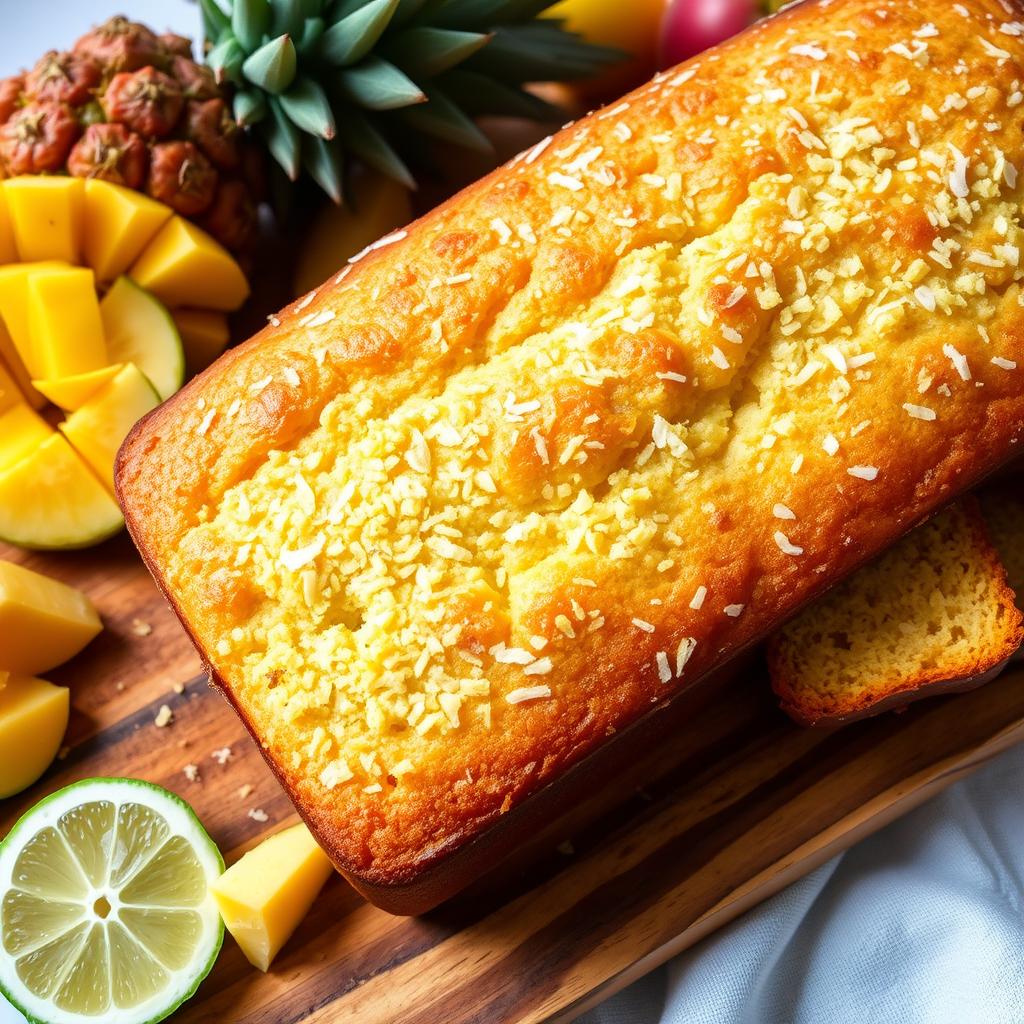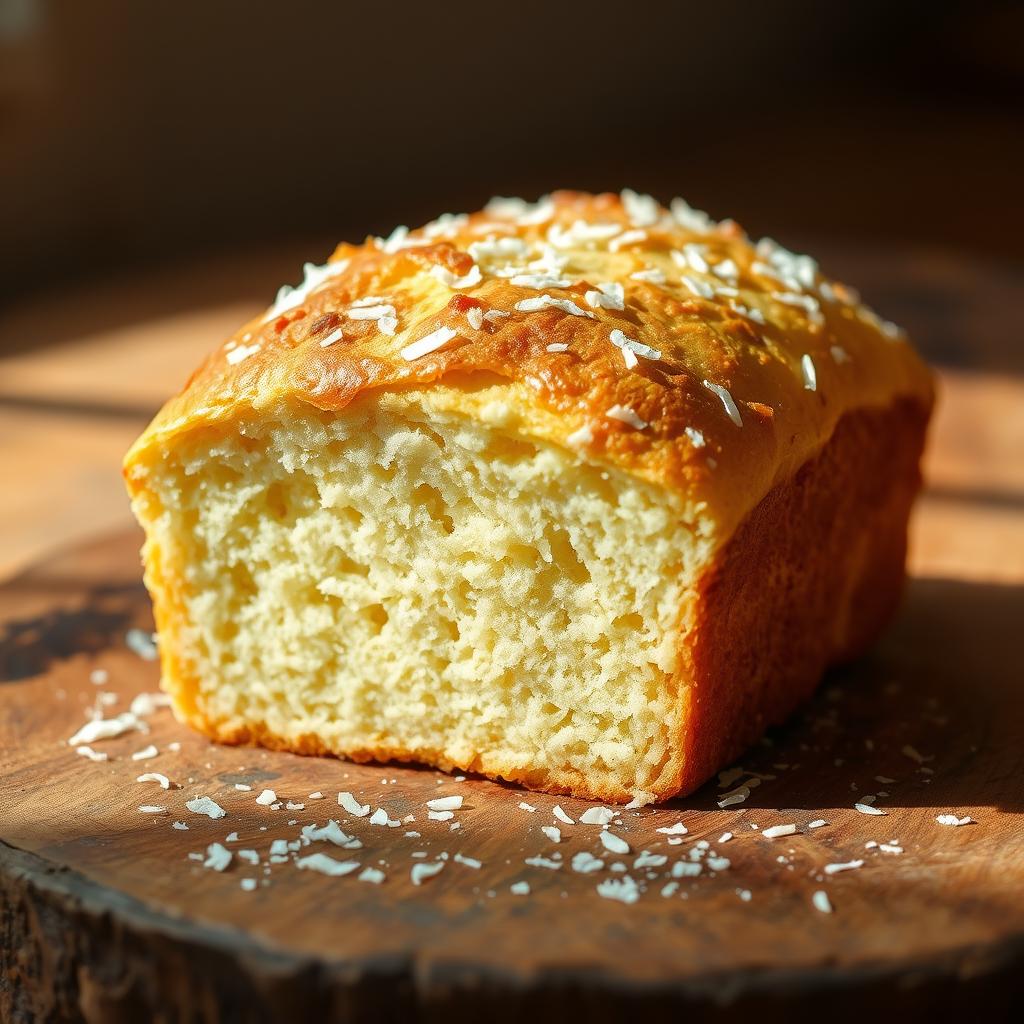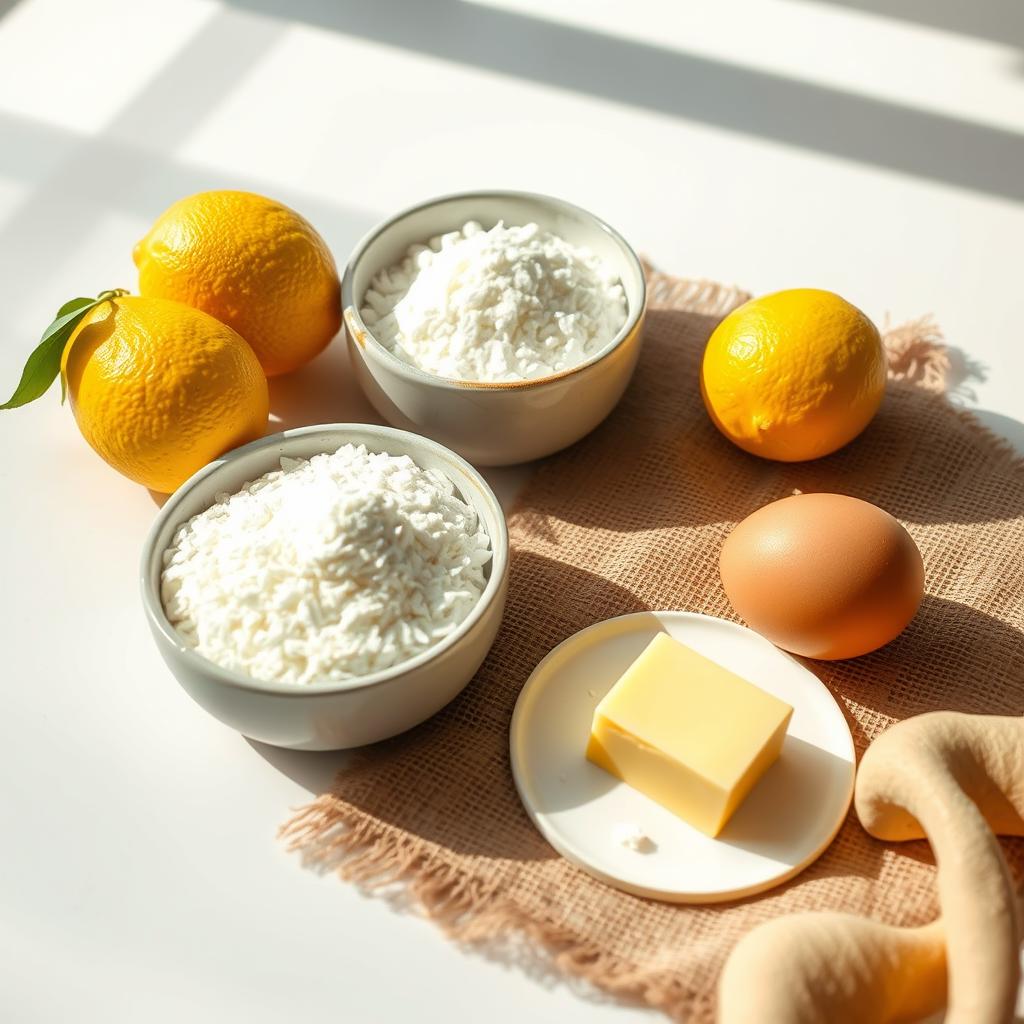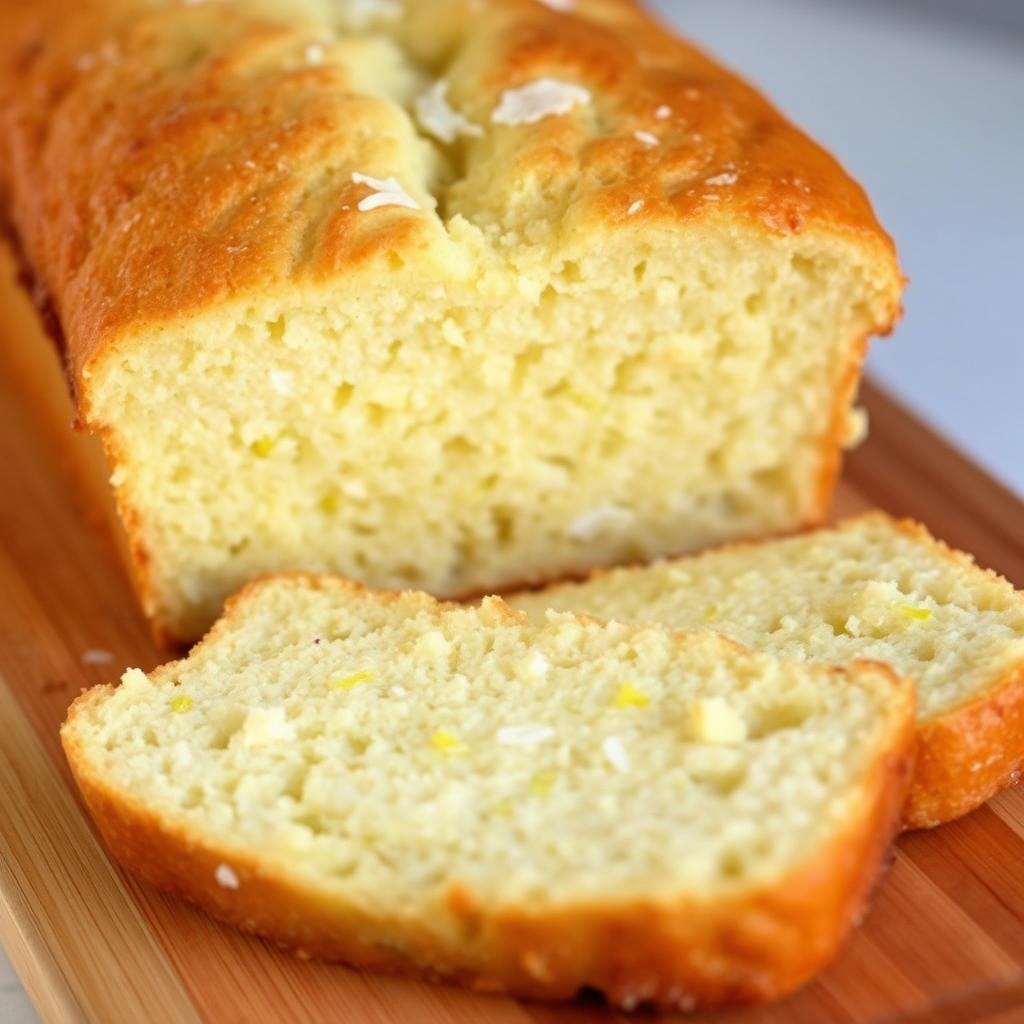Homemade lemon bread often brings a smile to the kitchen. This tropical bread recipe takes it further. Every bite of this lemon coconut bread offers a burst of zesty lemon paired with sweet, buttery coconut.
Perfect for breakfast or dessert, its moist crumb and golden crust make it a crowd-pleaser. This simple recipe needs no advanced skills—just basic baking tools and fresh ingredients. It’s the kind of treat that feels indulgent yet approachable, ready to brighten any meal.

Key Takeaways
- Easiest to make with pantry staples like butter, eggs, and shredded coconut.
- Zesty lemon and creamy coconut create a flavor balance that’s both refreshing and comforting.
- Perfect for any occasion—serve it warm with butter or as a dessert drizzled with glaze.
- Adaptable to dietary preferences using oil or yogurt swaps for a lighter version.
- A visually stunning tropical bread recipe that’s photographed-ready for social sharing.
Introduction to Lemon Coconut Bread
Lemon coconut bread is a tropical treat that brightens up any kitchen. It combines citrus zest with toasted coconut for a unique taste. It’s easy to make and loved by everyone, with a soft crumb and a tangy glaze.
What Makes This Recipe Special
This quick bread is special because it stays moist, thanks to buttermilk and shredded coconut. It’s simple to make, with no hard techniques needed. Each slice stays fresh for days, making it perfect for busy mornings or quick gatherings.
The Perfect Balance of Flavors
The tropical flavor bread has a zesty lemon glaze and chewy coconut. The lemon’s brightness balances the coconut’s richness. It’s a light yet indulgent taste that feels like a trip to the islands.
When to Serve This Delightful Bread
Enjoy warm slices with butter on weekend mornings, or give them as gifts. It’s great for Easter brunches or Memorial Day picnics. Pair it with coffee for breakfast or tea at holiday parties. Its versatility makes it a favorite all year.
The History and Origins of Citrus Quickbreads
Quick breads started with a big change in kitchens in the 19th century. The discovery of baking powder in the 1800s changed everything. Before, breads took hours to rise. Now, bakers could make moist loaves in just minutes.
This opened the door for new recipes, like citrus bread. These quick breads were a big leap forward.
Long before we mixed lemons with coconut, ancient cooks used citrus in their dishes. They added preserved lemons to breads for a tangy taste. Medieval cooks also used orange zest in early versions of lemon dessert bread.

In Victorian England, lemons became a sign of wealth. Rich families showed off their lemon cakes at tea time. Later, coconut became popular in American kitchens after trade routes opened up.
By the 1950s, coconut and citrus were together in many recipes. This led to the creation of lemon coconut bread we love today.
Today, recipes mix old traditions with new ideas. Every bite of this bread tells a story. It connects us to ancient citrus uses and mid-century experiments. Baking becomes a way to talk across time, not just mixing ingredients.
Health Benefits of Lemons and Coconut

Lemons and coconut are more than just a tasty duo. They’re a nutritional powerhouse. This nutritious quick bread is not just a treat. It’s a way to boost your health.
Nutritional Value of Lemons
Lemons are full of vitamin C, which is great for your immune system and skin. They also have antioxidants to fight off stress and fiber for better digestion. Plus, lemons help keep your body’s pH balanced, even though they taste sour. Here’s what they offer:
- Vitamin C: 1 lemon gives you 31% of what you need
- Natural antioxidants like hesperidin and naringenin
- Pectin fiber for steady energy and gut health
Coconut’s Health Properties
Coconut does more than add flavor. Its coconut health benefits include:
- MCTs (medium-chain triglycerides) for quick energy
- High in manganese for bone health and metabolism
- Copper for collagen production and iron absorption
“Coconut’s fats are metabolized differently, making it a smarter baking choice.” —Nutrition Today Journal
Why This Combination Works
| Category | Regular Quick Bread | Healthy Lemon Bread |
|---|---|---|
| Sugar | High added sugars | Natural lemon sweetness |
| Fats | Processed oils | Coconut’s MCTs |
| Nutrients | Low vitamin/mineral content | Vitamin C, fiber, and antioxidants |
Lemons and coconut together make a healthy lemon bread. It’s tasty and good for you. Enjoy it without feeling guilty!
Essential Ingredients for Perfect Lemon Coconut Bread
Mastering lemon coconut bread ingredients begins with picking quality baking ingredients. Each ingredient is crucial for texture and taste. Let’s explore the key components:
- Flour: All-purpose flour gives the bread structure. Choose flour with 11-12% protein for a tender crumb.
- Leavening: Baking powder and soda help the bread rise. Make sure they’re not past their expiration date.
- Salt: A small amount of salt enhances sweetness without overpowering the lemon flavor.
- Eggs: Eggs bind the wet and dry ingredients together. Use room-temperature eggs for smooth mixing.
- Fats: Butter adds richness, while coconut oil brings a tropical flavor.
Fresh lemon zest is essential. Use unwaxed lemons for the best citrus flavor. Only grate the colored part to avoid bitterness. You can choose between sweetened shredded coconut for moisture or toasted flakes for crunch.
“The difference between good and great bread starts with ingredient quality. Never skip fresh lemon zest—it’s the soul of this recipe.” – Master Baker Clara Nguyen

Sweeteners like brown sugar add moisture, while vanilla enhances the citrus flavor. Always check coconut for freshness. Dry, clump-free flakes bake the best. For a dairy-free option, use almond milk, but keep real lemon juice for acidity.
Every choice you make affects the final bread. Focus on freshness and balance for the best results!
Kitchen Tools You’ll Need
Every successful bake starts with the right gear. These baking tools and kitchen equipment make sure your loaf is golden and moist every time.

Basic Equipment
- Measuring cups and spoons: Precision is key for balanced flavors.
- Mixing bowls: Use glass or stainless steel for easy cleanup.
- Loaf pan sizes: A 9×5-inch metal or glass pan works best. Non-stick options prevent sticking.
- Whisk or mixer: A hand mixer speeds up mixing but a whisk works fine.
- Cooling rack: Let your bread cool upright to avoid sogginess.
Optional Tools for Enhanced Results
- Stand mixer: Great for thick batters but not essential.
- Digital scale: Ensures accurate ingredient ratios.
- Silicone spatula: Scrapes bowls clean for even mixing.
- Instant-read thermometer: Check internal temperature (190-210°F) for perfect doneness.
Substitutions in a Pinch
- No zester? Use a box grater for lemon zest.
- Missing parchment paper? Grease the pan with butter or oil.
- Substitute a 8×4-inch pan—adjust baking time by 5-10 minutes.
Most tools are accessible at home or local stores. Even basic kitchen equipment works—focus on what you have first!
Step-by-Step Lemon Coconut Bread Recipe

Learning the lemon coconut bread recipe begins with getting ready. Follow these steps for a moist lemon coconut loaf that everyone will adore. Let’s start!
Preparing Your Ingredients
- Zest lemons gently to avoid pith—use a microplane grater for fine, flavorful strips.
- Measure flour by spooning into the cup and leveling with a knife; never scoop directly.
- Bring butter and eggs to room temperature for smoother mixing.
Mixing the Batter
- Cream butter and sugar until light and fluffy—this traps air for a tender crumb.
- Alternate dry and wet ingredients: add half the dry mix, then buttermilk and coconut, then remaining dry mix. Fold gently.
- Stir in lemon zest last to preserve bright flavors. Stop mixing once combined.
Baking Tips for Moist Results
For a moist lemon coconut loaf:
- Grease and flour the pan thoroughly. Line the bottom with parchment paper for easy removal.
- Preheat the oven to 325°F (160°C)—low and slow bakes evenly.
- Rotate the pan halfway through baking for even browning. Tent with foil if top browns too fast.
- Brush warm bread with a simple syrup (equal parts sugar and lemon juice) for extra moisture.
How to Tell When It’s Done
Check three ways:
- Insert a toothpick—clean crumbs mean done.
- Internal temperature reaches 200°F (93°C).
- Edges pull away from the pan; the top springs back when lightly pressed.
Let cool in the pan for 10 minutes before transferring to a rack. Enjoy warm or at room temperature!
Troubleshooting Common Baking Issues
Baking lemon coconut bread? Let’s tackle quick bread troubleshooting with easy fixes! If your loaf looks sunken, check baking time—overly soft centers mean underbaking. Avoid opening the oven too soon; steam loss can collapse the structure. For fixing dry bread, ensure ingredients are measured by weight, not volume, for accuracy. Overmixing or old baking powder? Swap for fresh leaveners next try.
- Sunken Loaf: Extend bake time 5-10 minutes. Test doneness with a toothpick.
- Sticky Pan: Grease with coconut oil spray and line with parchment for nonstick success.
- Cracks or splits: Lower oven temp 25°F and shield top with foil halfway through baking.
Ingredient separation? Mix wet and dry separately first, then combine gently. Too much lemon zest? Add more flour to balance moisture. Remember, even pros face quick bread troubleshooting challenges—each mistake teaches texture secrets! If your bread’s too dense, try replacing half the flour with almond meal for lighter crumb.
“Baking’s like gardening—some days it blooms, others you dig deeper. Keep trying!”
Still stuck? Brush warm bread with lemon syrup (equal parts water and honey simmered) to restore moisture. Fixing dry bread post-bake? Slice and steam in a covered dish with a hot water-filled mug for 5 minutes. With these tips, even a sunken loaf becomes a learning win. Happy mixing!
Delicious Variations of Lemon Coconut Bread
Make your lemon coconut bread truly yours with these tested variations. Whether you need to make it gluten-free or just want to try new flavors, these changes will make every bite special.
Gluten-Free Option
For gluten-free lemon coconut bread, use a 1:1 gluten-free flour blend like Bob’s Red Mill or King Arthur Measure for Measure. Add ½ teaspoon xanthan gum per cup of flour to keep it moist. Bake for 5-7 minutes longer for a golden crust.
Vegan Adaptation
Turn it into a vegan lemon bread by using flax eggs (1 tbsp ground flax + 3 tbsp water per egg) and Earth Balance butter. Replace milk with unsweetened almond or oat milk. Stir well before mixing to avoid soggy crumbs.
Adding Extra Flavors and Mix-ins
- Blueberries or raspberries: Fold in ½ cup fresh or thawed frozen fruit
- White chocolate chips: Add ¼ cup for a decadent surprise
- Ginger or lime zest: Stir in 1 tsp for a tropical twist
“I added macadamia nuts to my lemon bread variations and it became my family’s new favorite!” – Sarah, gluten-free baker
When adding mix-ins, bake for 2-3 minutes longer. Always check with a toothpick to see if it’s done. These changes keep your kitchen creative without losing the bread’s tangy coconut flavor.
Serving Suggestions and Pairings
Make your lemon coconut bread shine with these simple tips. It’s perfect for breakfast or as a sweet treat after dinner. These ideas bring out its tropical flavors. Start your day with these breakfast quick bread tricks or enjoy it as a dessert that everyone will love.
Breakfast Ideas
- Slice warm bread and spread with butter or coconut butter for a creamy touch.
- Pair with tropical fruits like mango or pineapple to boost citrus and coconut notes.
- Top with Greek yogurt and honey for a protein-packed breakfast quick bread combo.
Dessert Presentations
For a sweet finish, try these tropical twists:
- Warm slices with vanilla or coconut ice cream and drizzle with white chocolate.
- Layer cubes with whipped cream and berries in a trifle bowl.
- Make bread pudding by soaking slices in spiced coconut milk before baking.
Beverage Pairings
| Drink Type | Suggestion |
|---|---|
| Hot | Earl Grey tea or chai for a citrus-herb contrast |
| Cold | Iced coffee with coconut milk or a tropical smoothie |
| Adult | Coconut rum punch or sweet dessert wines like Sauternes |
These tropical bread pairings are flexible—mix, match, and make them your own. Share your favorite ways to enjoy this bread in the comments!
Storing and Freezing Your Bread
Keep your lemon coconut bread fresh with these tips. Cool the bread completely on a wire rack to avoid sogginess. Store it in an airtight container at room temperature for up to 3 days. Don’t refrigerate it, as it can dry out faster.
- Freezing quick bread: Wrap cooled loaves in plastic wrap, then foil. Label with the date and freeze for up to 3 months.
- Thaw at room temperature 4–6 hours before serving. For a quick fix, warm slices in a 300°F oven for 5–7 minutes.
- Glazed loaves? Freeze unglazed first. Add frosting 1 hour before serving to prevent melting.
Refrigerate only if your kitchen stays above 75°F. Use within 5 days in a sealed container. To revive dry slices, lightly steam in a microwave with a damp paper towel. Never refreeze thawed bread—enjoy it within 24 hours instead.
“The best part? Frozen loaves make perfect gifts! Just add a handwritten note.”
Check for mold or off smells before serving. Properly stored, this bread stays fresh-tasting up to 3 months when frozen. Adjust techniques based on your climate, and always prioritize food safety. Now you can enjoy bakery-quality bread anytime, without the rush!
What Readers Love About This Lemon Coconut Bread
This reader favorite bread has become a hit, moving from kitchen counters to picnic baskets. Real fans share why they keep coming back to this popular quick bread recipe.
Testimonials and Reviews
“The tangy-sweet blend is perfect,” says Mary from Texas, who serves it at family brunches. “My kids ask for it weekly!” Bakers praise its reliability: “No failed batches here,” notes Chef Lisa on her blog. Many highlight the recipe’s adaptability, from gluten-free tweaks to holiday variations. Check out this lemon coconut bread reviews roundup:
“Best quick bread I’ve ever made. The coconut adds such depth!” – Kevin
Social Media Highlights
On Instagram, users share creative twists: blueberries added, or served with mascarpone. Pinterest pins tag it as a “weekend staple.” A trending post by @BakeHappy reads: “This popular quick bread recipe is my go-to for gifts!”
- #LemonCoconutLove has over 5k posts, featuring breakfast spreads and bake sales.
- Users rave about its “flawless texture” and “zesty kick.”
Want your post featured? Tag #LemonCoconutBreadRevival and show us your loaves! Whether for gifting or gifting, this bread earns its spot as a top pick.
Conclusion
Homemade lemon coconut bread adds a burst of sunshine to your kitchen. It mixes bright citrus with creamy coconut for a unique taste. This easy recipe is perfect for beginners and lets you get creative.
It’s great with butter or coffee, offering a mix of simplicity and indulgence. Baking this bread is more than just the result—it’s the joy of mixing and the pride of sharing. You can make it gluten-free or add nuts or spices to suit your taste.
Next time you want something sweet, try making this tropical quick bread. It’s incredibly satisfying to make from scratch. So, grab your mixing bowl and let the oven’s warmth guide you to a slice of homemade happiness. Your kitchen and guests will thank you.
FAQ
What kind of lemons should I use for this recipe?
Choose fresh, juicy lemons for the best zest and juice. Opt for unwaxed lemons for pure flavor. Meyer lemons add a sweet twist.
Can I substitute coconut oil for butter in the recipe?
Yes, melted coconut oil is a great dairy-free substitute. Just measure it in its liquid form for the right amount.
How should I store leftover lemon coconut bread?
Keep it in an airtight container at room temperature for up to three days. For longer storage, wrap it tightly in plastic wrap and freeze for up to three months.
What can I add to the bread for extra flavor?
Get creative! Try adding chocolate chips, blueberries, or nuts. Just make sure they don’t change the bread’s moisture too much.
What should I do if my bread turns out too dry?
If it’s dry, it might have been overbaked. Next time, check for doneness a bit earlier. Brushing the top with lemon syrup can also help.
Is this recipe adaptable for gluten-free diets?
Absolutely! Use a gluten-free flour blend. Make sure it has xanthan gum or add it separately to help the bread stick together.
How can I tell when the bread is done baking?
It’s done when a toothpick comes out clean and the edges pull away. The top should be golden and springy when touched.
Can I make this lemon coconut bread vegan?
Yes! Replace eggs with flax eggs or chia seeds, use non-dairy milk, and swap butter for a plant-based option.
What occasions are best for serving lemon coconut bread?
It’s great for breakfast, brunch, afternoon tea, or dessert. It’s also a wonderful gift for loved ones.
How can I enhance the presentation of my lemon coconut bread?
Dust it with powdered sugar, drizzle with lemon glaze, or serve with fresh fruit. It looks and tastes amazing.
